Marcoat was a minor Gascon troubadour and joglar who flourished in the mid twelfth century. He is often cited in connexion with Eleanor of Aquitaine and is placed in a hypothetical "school" of poetry which includes Bernart de Ventadorn, Marcabru, Cercamon, Jaufre Rudel, Peire Rogier, and Peire de Valeria among others. [1] Of all his works, only two sirventes survive: Mentre m'obri eis huisel and Una re.us dirai, en Serra. [2]
Marcoat was an innovator building off the work of the contemporary Gascon Marcabru, [3] whose death he recalls in one of his works c. 1150. [4] Nonetheless, his works are very simple, the stanzas being composed of three heptasyllables rhyming in the form AAB. [2] It was he who first used the term sirventes to describe his poems; [2] the word appears in both of his surviving works, twice in one:
The meaning of these verses is obscure, as he was an early practitioner of the trobar clus style. [3] [6] According to himself, he wrote vers contradizentz (contradictory verses). [6] He was a model for the later troubadour Raimbaut d'Aurenga. [3]
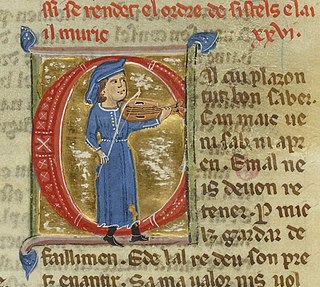
A troubadour was a composer and performer of Old Occitan lyric poetry during the High Middle Ages (1100–1350). Since the word troubadour is etymologically masculine, a female troubadour is usually called a trobairitz.

Marcabru is one of the earliest troubadours whose poems are known. There is no certain information about him; the two vidas attached to his poems tell different stories, and both are evidently built on hints in the poems; not on independent information.
Trobar clus, or closed form, was a complex and obscure style of poetry used by troubadours for their more discerning audiences, and it was only truly appreciated by an elite few. It was developed extensively by Marcabru and Arnaut Daniel, but by 1200 its inaccessibility had led to its disappearance. Among the imitators of Marcabru were Alegret and Marcoat, who claimed himself to write vers contradizentz, indicative of the incomprehensibility of the trobar clus style. Below is a sample of the style from Marcoat's sirventesMentre m'obri eis huisel, wherein the poet himself remarks on his moz clus :

The Canso d'Antioca is a late twelfth-century Occitan epic poem in the form of a chanson de geste describing the First Crusade up to the Siege of Antioch (1098). It survives only in a single manuscript fragment of 707 alexandrines, now preserved in Madrid.

Peirol or Peiròl was an Auvergnat troubadour who wrote mostly cansos of courtly love in the late twelfth and early thirteenth centuries. Thirty-four surviving poems written in Occitan have been attributed to him; of these, seventeen have surviving melodies. He is sometimes called Peirol d'Auvergne or Peiròl d'Auvèrnha, and erroneously Pierol.

Jordan Bonel, sometimes also de Confolens, was a troubadour from western Aquitaine about whom very little is definitively known except that he was associated with the court of Alfonso II of Aragon. His vida states that he was from Saintonge and he appears to have been contemporary with Bertran de Born. His surviving corpus probably consists of three cansos, wherein only one is attributed to him, though its melody survives:
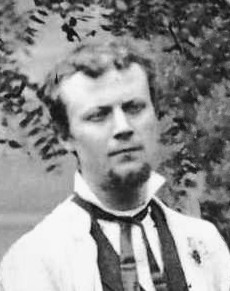
Alfred Jeanroy was a French linguist.

The (Lo) Monge de Montaudon, born Pèire de Vic, was a nobleman, monk, and troubadour from the Auvergne, born at the castle of Vic-sur-Cère near Aurillac, where he became a Benedictine monk around 1180. According to his vida, he composed "couplets while he was in the monastery and sirventes on subjects that were popular in the region."
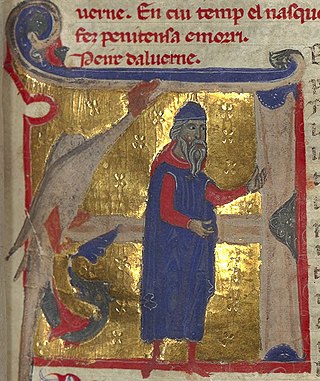
Peire d'Alvernhe or d'Alvernha was an Auvergnat troubadour with twenty-one or twenty-four surviving works. He composed in an "esoteric" and "formally complex" style known as the trobar clus. He stands out as the earliest troubadour mentioned by name in Dante's Divine Comedy.
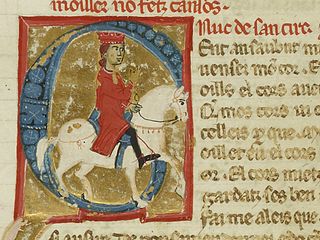
Uc de Saint Circ or Hugues (Hugh) de Saint Circq was a troubadour from Quercy. Uc is perhaps most significant to modern historians as the probable author of several vidas and razos of other troubadours, though only one of Bernart de Ventadorn exists under his name. Forty-four of his songs, including fifteen cansos and only three canso melodies, have survived, along with a didactic manual entitled Ensenhamen d'onor. According to William E. Burgwinkle, as "poet, biographer, literary historian, and mythographer, Uc must be accorded his rightful place as the 'inventor' (trobador) of 'troubadour poetry' and the idealogical trappings with which it came to be associated."
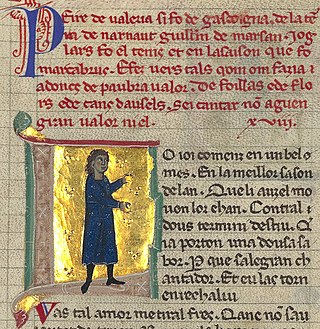
Peire de Valeira, Valeria, or Valera was a Gascon troubadour. Since troubadour poetry probably originated in northwest Aquitaine and first spread—within a generation—south into Gascony, Peire was one of the earliest troubadours. Only two of his poems survive, one canso and one cobla.
Alegret was a Gascon troubadour, one of the earliest lyric satirists in the Occitan tongue, and a contemporary of Marcabru. One sirventes and one canso survive of his poems. Nonetheless, his reputation was high enough that he found his way into the poetry of Bernart de Ventadorn and Raimbaut d'Aurenga. The work of Alegret is also intertextually and stylistically related to that of Peire d'Alvernhe.
Bertran Carbonel was a Provençal troubadour from Marseille. He is a polarising figure among scholars and his reputation varies between authorities. Eighteen of his lyric works survive, as well as seventy-two or ninety-four (Riquer) single coblas triadas esparsas on "edifying" themes. He was patronised at the court of Hugh IV and Henry II of Rodez.

Peire Bremon Ricas Novas was a Provençal troubadour who left behind twenty works: thirteen cansos, six sirventes, and one tenso. His treatment of courtly love was somewhat original.

Bernart de Venzac was an obscure troubadour from Venzac near Rodez in the Rouergue. He wrote in the Marcabrunian style, leaving behind five moralising pieces and one religious alba. Two of his works were confused by copyists with those of Marcabru in some manuscripts.
Gavaudan was a troubadour and hired soldier at the courts of both Raymond V and Raymond VI of Toulouse and later on in Castile. He was from Gévaudan, as his name implies. He wrote moralising lyrics, either religious or political, and ten of his works survive, including five sirventes, two pastorelas, one canso, one planh for an anonymous domna (lady), and one Crusade song. He is sometimes clumped in a primitive Marcabrunian "school" of poetry alongside Bernart Marti, Bernart de Venzac, and Peire d'Alvernhe. He developed a hermetic style, combining elements of the trobar ric and trobar clus.
A gab or gap is a troubadour boasting song. It is often considered related to the tenso and partimen, two types of debate poem. Sometimes the gab is not considered a separate genre of poetry but simply a boast found within another genre, commonly the sirventes.
Peire de Corbiac or Corbian was a Gascon cleric and troubadour of the thirteenth century. His most famous works are a religious piece, the Prière à la Vierge, and his "treasures", Lo tezaurs.
A Crusade song is any vernacular lyric poem about the Crusades. Crusade songs were popular in the High Middle Ages: 106 survive in Occitan, forty in Old French, thirty in Middle High German, two in Italian, and one in Old Castilian. The study of the Crusade song, which may be considered a genre of its own, was pioneered by Kurt Lewent. He provided a classification of Crusade songs and distinguished between songs which merely mentioned, in some form, a Crusade from songs which were "Crusade songs". Since Lewent, scholars have added several classifications and definitions of Crusade songs. Scholars have argued for three different classifications of Crusade songs which include songs of exhortation, love songs, and songs which criticize the Crusading movement.
Amanieu de la Broqueira was a Gascon troubadour. His name suggests he was from Labroquère, near Saint-Bertrand-de-Comminges. He wrote two cansos that have been preserved in the 14th-century troubadour chansonnier E :